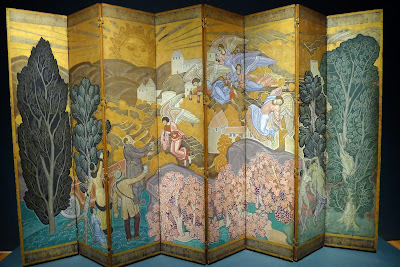 |
| Wouldn’t it be nice to have a Van Gogh–impasto and all–hanging on your wall? His Wheat Field with Cypresses, 1889, for example. |
I really love Van Gogh, but never felt like hanging a print of his work on my wall. Paintings which sing through their brushwork tend to look anemic in prints. Printing technology has improved amazingly over my lifetime, but the ability to capture impasto has thus far eluded us.
Dutch researcher
Tim Zaman may have broken that barrier. He has developed an image capture technique capable of recording a painting’s surface details. The captured image is then reproduced using
Océ high-resolution 3D print technology (brought to us by Canon, of course). The process works like a dye-sublimation printer, with the printing head moving back and forth many times, adding a new textured layer with each pass.
Reproductions with brushwork have existed as long as there has been offset color printing: the texture was simply brushed over the printed image (a slightly-nicer version of decoupage). Marrying this to giclée* printing—with its great color accuracy and fine grain—could give an awfully good imitation of a painting. But not even the best “enhanced” giclée print on the market would ever be confused with an original painting.
Ever since Durer was making wood-block prints of the Passion, there’s been an effort to bring art to the masses. It’s been a losing battle, since art is essentially elitist (which is why museums wax rich selling images of paintings by artists who never earned a penny from their work in their lifetimes).
Now, imagine being able to buy an exact replica of, say, Anselm Kiefer’s Nigredo—with straw and other stuff sticking out of its surface—for, say, five thousand bucks. Sure, it’s an absurd price for a print, but a bare fraction of the cost of the original. If you are interested in disseminating art to the masses, this is a fantastic trend.
And what about being able to see a virtual Mona Lisa up close and personal, instead of from 45 feet away and behind bullet-proof glass? The real painting could be retired to an oxygen-free tank, and its exact copy displayed for the masses. When some idiot attacks it, the copy can be quietly retired and a new one printed to take its place. Or how about having a virtual Mona Lisa in every city art gallery, instead of just at the Louvre?
 |
| Anselm Kiefer’s Nigredo, 1984, would look a heckuva lot better in a 3D print than in a flat one. |
(If you object to that, you might be mistaken about just how much of the Mona Lisa that we see today was laid down by the hand of Da Vinci. By the time a painting has undergone generations of conservation, it’s more of a collaboration than a masterwork.)
*If the word giclée bugs you, you’re a smart student of language. It’s an American neologism for high-end inkjet prints. It is based on the French gicleur, or “nozzle.” Rumor has it that it is also modern French slang for ejaculation, so I have to remember to not use it when in France.
One more workshop left this year! Join me in October, 2013 at Lakewatch Manor—which is selling out fast—or let me know if you’re interested in painting with me in 2014. Click here for more information on my Maine workshops!













